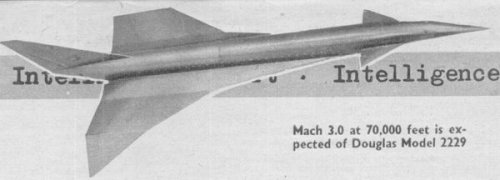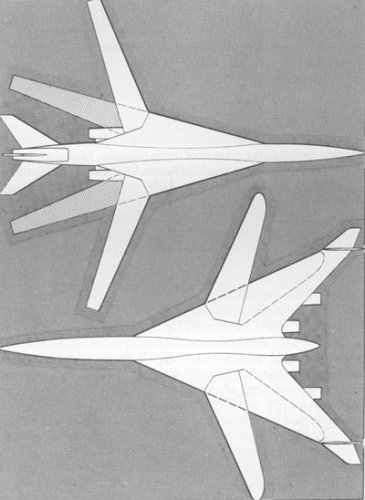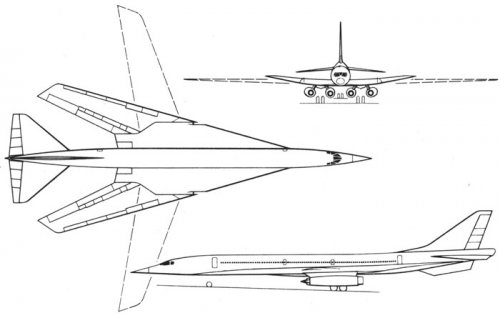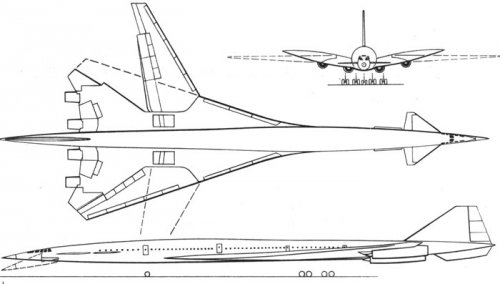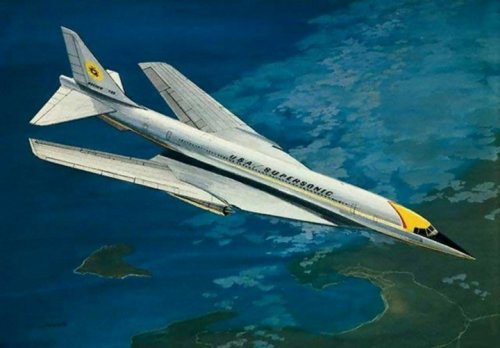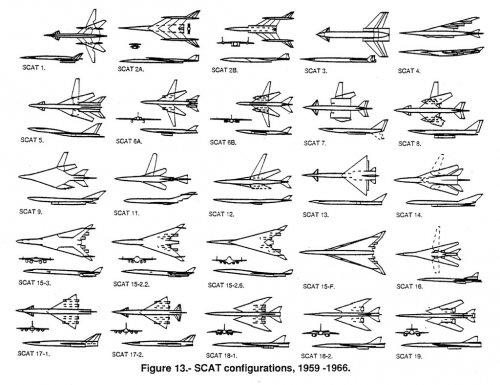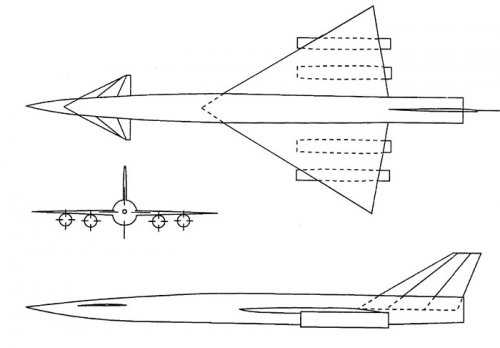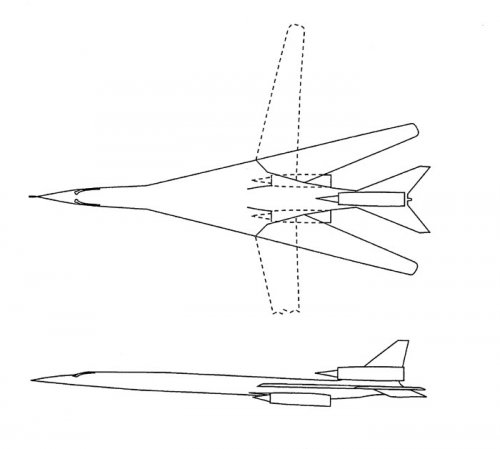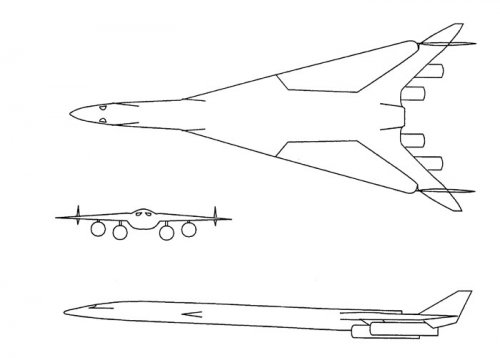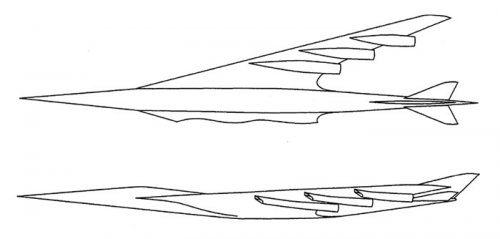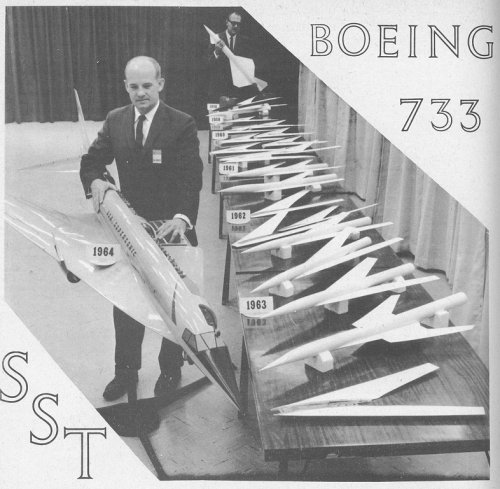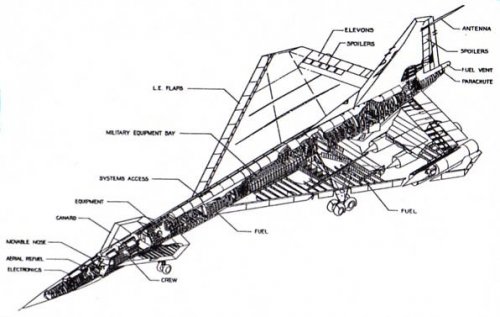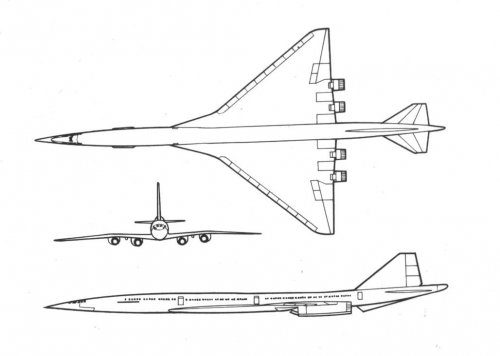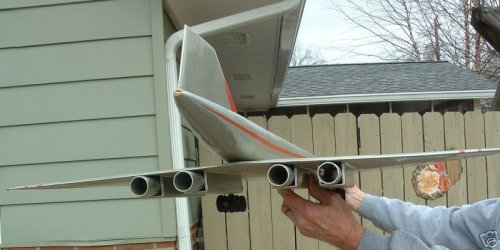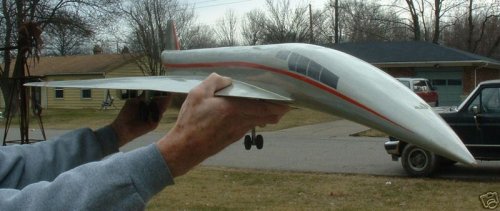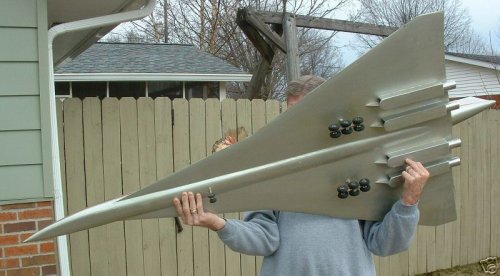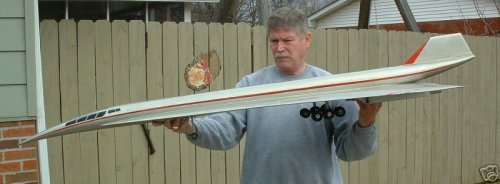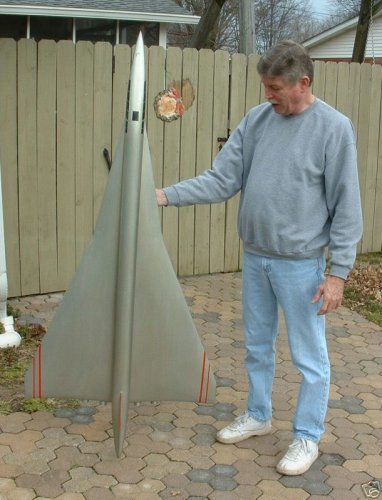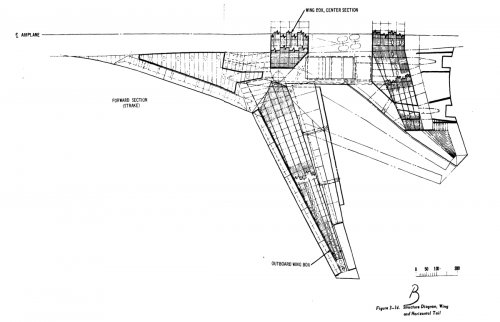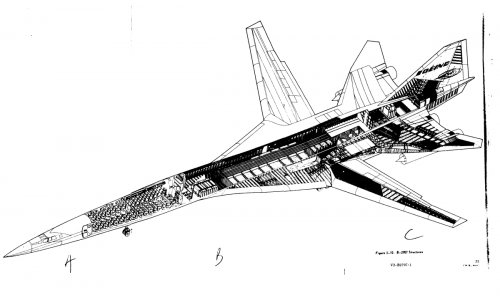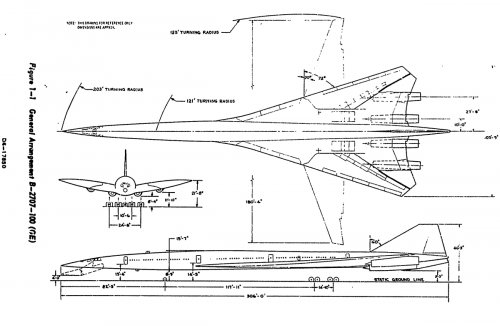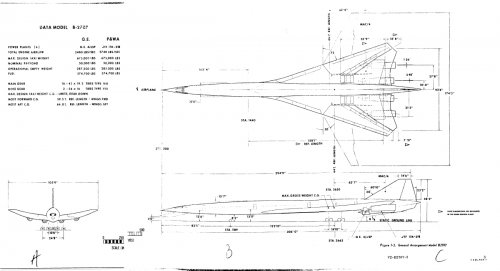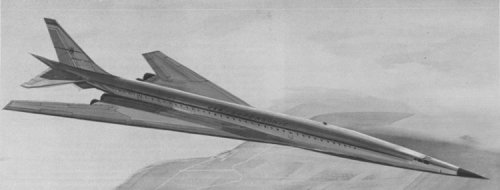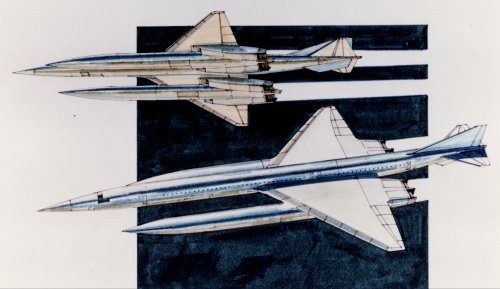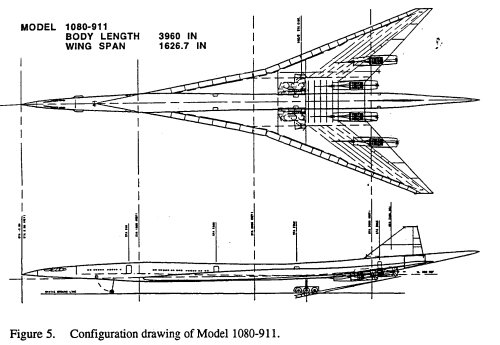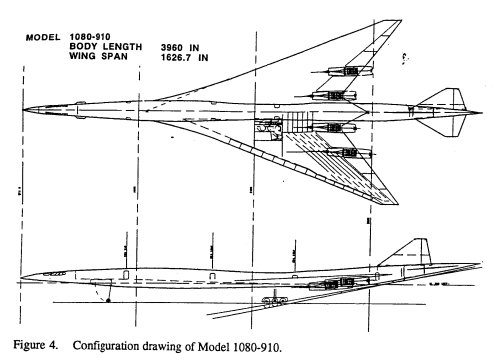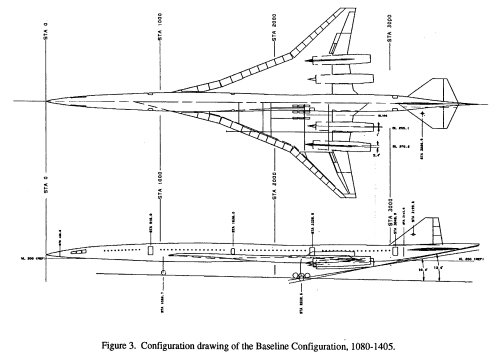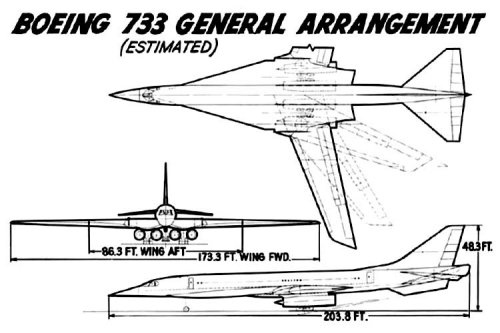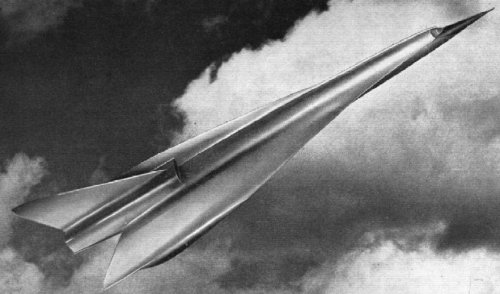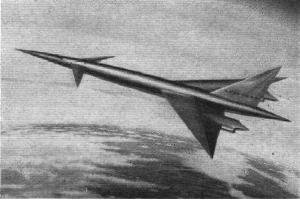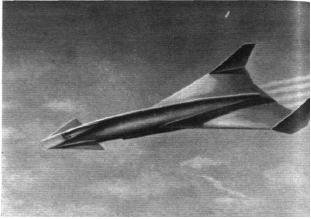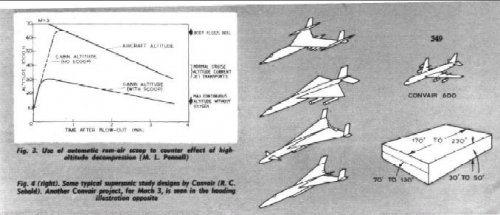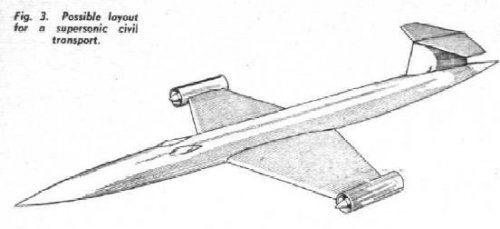You are using an out of date browser. It may not display this or other websites correctly.
You should upgrade or use an alternative browser.
You should upgrade or use an alternative browser.
US Supersonic Transport (SST) Program 1960-1971
- Thread starter Orionblamblam
- Start date
- Joined
- 11 March 2006
- Messages
- 8,624
- Reaction score
- 3,792
- Joined
- 27 September 2006
- Messages
- 6,416
- Reaction score
- 6,805
Another blast from the past.
I was leafing through some American magazines at a Plane Fair and noticed a small picture of a C5 tanker refueling what was described as the Boeing SST, both in 60s all metal USAF colours. The Boeing SST was the large 2707 swing wing version. It looked amazing as a USAF transporter (presumably Boeing hoped that like the 707 they could use the USAF as a start-up customer). I have seen models of an Air Force One version of the SST on Ebay, though these are modern in origin.
The idea must have been dropped before the swing wing version gave way to the 2707-300 delta version as I have never seen any artwork of this in USAF colours.
Now that Revell have re-released their SST kit it is worth recalling that some 26 airlines flirted with the SST by taking up options including:
Aer Lingus, Aeronaves de Mexico (lapsed in 1967),Air Canada, Air France, Airlift (a battered model of this was on Ebay a few years back), American, BOAC, Braniff, Continental, Delta, Eastern, El Al, KLM, Japan Air, Lufthansa, Northwest, Panagra (lapsed in 1966), Panair do Brasil (lapsed in 1967), Pan Am, Transamerica,TWA, United
I was leafing through some American magazines at a Plane Fair and noticed a small picture of a C5 tanker refueling what was described as the Boeing SST, both in 60s all metal USAF colours. The Boeing SST was the large 2707 swing wing version. It looked amazing as a USAF transporter (presumably Boeing hoped that like the 707 they could use the USAF as a start-up customer). I have seen models of an Air Force One version of the SST on Ebay, though these are modern in origin.
The idea must have been dropped before the swing wing version gave way to the 2707-300 delta version as I have never seen any artwork of this in USAF colours.
Now that Revell have re-released their SST kit it is worth recalling that some 26 airlines flirted with the SST by taking up options including:
Aer Lingus, Aeronaves de Mexico (lapsed in 1967),Air Canada, Air France, Airlift (a battered model of this was on Ebay a few years back), American, BOAC, Braniff, Continental, Delta, Eastern, El Al, KLM, Japan Air, Lufthansa, Northwest, Panagra (lapsed in 1966), Panair do Brasil (lapsed in 1967), Pan Am, Transamerica,TWA, United
- Joined
- 22 January 2006
- Messages
- 4,212
- Reaction score
- 2,007
looked amazing as a USAF transporter
Wow!, maybe one of the forum artists could produce the profile :
C5 tanker
This is even more amazing. Could you describe this configuration?. Any chance to see a pic?. I think Boeing opposed a 747 tanker version to the KC-10 and also it was a Tristar Tanker but never heard about C-5 tanker versions in the 60's. This should be a private iniciative from Lockheed ???
There's a colour illustration on the cover of
'Air Force and Space Digest' of Februar 1967.
A blue sky with two silver planes - an early C-5 or lookalike
refuelling a Boeings swingwing SST in Air Force markings.
Air Trails Military Aircraft -1971 presents an article
with the Boeing swing-wing SST , again in military guise with the
title : 'World Fastest Flying Command Post - Shot Down '
'Air Force and Space Digest' of Februar 1967.
A blue sky with two silver planes - an early C-5 or lookalike
refuelling a Boeings swingwing SST in Air Force markings.
Air Trails Military Aircraft -1971 presents an article
with the Boeing swing-wing SST , again in military guise with the
title : 'World Fastest Flying Command Post - Shot Down '
Hello! Not exactly the topic of this thread, but its better using this one than create another
I'm searching dimensions of the fixed-wing 2707-300. The final aircraft (tailed delta, 234 seats).
Length and span would be welcome!!! (on the web are only dimensions of this damned swing-wing design )
)
I'm searching dimensions of the fixed-wing 2707-300. The final aircraft (tailed delta, 234 seats).
Length and span would be welcome!!! (on the web are only dimensions of this damned swing-wing design
Matej
Multiuniversal creator
The proposed Boeing 2707-300 SST was designed for 290 passengers. It had a 69,000-pound payload with four turbofan engines mounted about the center section of the wings, which carry JP-4 propellant. The vehicle had a reference lengtb of 315 feet, a wingspan of 126.8 feet, and a total gross weight of 640,000 pounds.
Use of stability augmentation methods during preliminary design led to a 150 inch reduction in fuselage length for the Boeing 2707-300 SST. The shortened fuselage also led to reduced vertical tail size and gear length, with a weight savings of 6,000 lbs and a range increase of 225 nautical miles.
http://www.globalsecurity.org/military/systems/aircraft/b2707-design.htm
Use of stability augmentation methods during preliminary design led to a 150 inch reduction in fuselage length for the Boeing 2707-300 SST. The shortened fuselage also led to reduced vertical tail size and gear length, with a weight savings of 6,000 lbs and a range increase of 225 nautical miles.
http://www.globalsecurity.org/military/systems/aircraft/b2707-design.htm
- Joined
- 3 June 2011
- Messages
- 18,328
- Reaction score
- 12,200
pometablava said:Please, check your email box. I think it could be what you're looking for
Any chance you could put them in my mailbox too?
Sentinel Chicken
American 71 Heavy, contact departure 126.47
(Raises hand)
Might I impose upon you to visit my email box as well?
Might I impose upon you to visit my email box as well?
Sentinel Chicken
American 71 Heavy, contact departure 126.47
Thank you very much, Antonio! Time to try an illustration, perhaps.....
- Joined
- 3 June 2011
- Messages
- 18,328
- Reaction score
- 12,200
pometablava said:sferrin,
check your email
regards
Antonio
Thanks a bunch ;D
- Joined
- 27 December 2005
- Messages
- 17,743
- Reaction score
- 26,335
I know we've touched on various designs like the Boeing 2707 elsewhere, but I'm interested in a systematic look at US SST programs.
NASA Langley did a huge amount of research into basic configurations for SST design starting from 1962. Some of the configurations they came up with were:
SCAT-4
Fixed-wing design, highly integrated wing, fuselage and engines and tail into a highly swept, cambered and twisted aircraft design minimising wave drag.
SCAT-15
Auxiliary wing design somewhat like the D-24 Alliance concept but with no horizontal tail surface
SCAT-16
VG design a lot like B-1/Tu-160
SCAT-17
Fixed delta wing with a canard forward surface
Boeing's early SST design was 733-197, in early 1964. This carried 150 passengers, with a gross weight of 430,000lb and a cruise speed of Mach 2.7. Basic structural material was titanium, and wing sweep varied from 20 deg to 74 deg. 4 afterburning turbofans such as the GE4/F6A in the 50-60,000lb category were mounted in individual pods across the wing carry through.
By November 1964 development had moved to the 733-290, with sweep angles now 30 deg to 72 deg and engines moved further aft. Passenger load was now 241, but gross weight was increased to 500,000lb.
18 months later, Boeing had progressed to the 2707-100. Gross takeoff weight had risen now to 675,000lb, and a new, enlarged tailplane fitted flush against the wing in maximum sweep to form a single modified delta planform lifting surface. Engines were again moved aft, to just under the tailplane. Length was now 306ft.
By November 1967, the Model 2707-200 was 318ft long, and now housed 292 passengers in a typical mixed configuration, with moveable canard surfaces on the forward fuselage.
In October 1968, Boeing announced it had shelved the VG SST and was working on a fixed wing design, the Model 2707-300. The integrated wing/tail concept wasn't working - the rear engine position resulted in poor mass distribution, and the control surfaces were closely coupled to the CG reducing stability. The canards added to 2707-200 had just made matters worse, not better.
The final cancellation of the program happened on 24th March 1971 when the US Senate voted against further financial backing.
Source:
"Annals of the Polymorph" Air International, May 1975.
NASA Langley did a huge amount of research into basic configurations for SST design starting from 1962. Some of the configurations they came up with were:
SCAT-4
Fixed-wing design, highly integrated wing, fuselage and engines and tail into a highly swept, cambered and twisted aircraft design minimising wave drag.
SCAT-15
Auxiliary wing design somewhat like the D-24 Alliance concept but with no horizontal tail surface
SCAT-16
VG design a lot like B-1/Tu-160
SCAT-17
Fixed delta wing with a canard forward surface
Boeing's early SST design was 733-197, in early 1964. This carried 150 passengers, with a gross weight of 430,000lb and a cruise speed of Mach 2.7. Basic structural material was titanium, and wing sweep varied from 20 deg to 74 deg. 4 afterburning turbofans such as the GE4/F6A in the 50-60,000lb category were mounted in individual pods across the wing carry through.
By November 1964 development had moved to the 733-290, with sweep angles now 30 deg to 72 deg and engines moved further aft. Passenger load was now 241, but gross weight was increased to 500,000lb.
18 months later, Boeing had progressed to the 2707-100. Gross takeoff weight had risen now to 675,000lb, and a new, enlarged tailplane fitted flush against the wing in maximum sweep to form a single modified delta planform lifting surface. Engines were again moved aft, to just under the tailplane. Length was now 306ft.
By November 1967, the Model 2707-200 was 318ft long, and now housed 292 passengers in a typical mixed configuration, with moveable canard surfaces on the forward fuselage.
In October 1968, Boeing announced it had shelved the VG SST and was working on a fixed wing design, the Model 2707-300. The integrated wing/tail concept wasn't working - the rear engine position resulted in poor mass distribution, and the control surfaces were closely coupled to the CG reducing stability. The canards added to 2707-200 had just made matters worse, not better.
The final cancellation of the program happened on 24th March 1971 when the US Senate voted against further financial backing.
Source:
"Annals of the Polymorph" Air International, May 1975.
Attachments
- Joined
- 27 December 2005
- Messages
- 17,743
- Reaction score
- 26,335
- Joined
- 27 December 2005
- Messages
- 17,743
- Reaction score
- 26,335
All the SCAT configurations....
Source: NASA-TM-109089 The evolution of the high-speed civil transport
 ntrs.nasa.gov
ntrs.nasa.gov
Source: NASA-TM-109089 The evolution of the high-speed civil transport
The evolution of the high-speed civil transport - NASA Technical Reports Server (NTRS)
Current research directed toward the technology requirements for a high-speed civil transport (HSCT) airplane is an outgrowth of many years of activity related to air transportation. The purpose was to review some of the events that provided the background upon which current research programs...
Attachments
Last edited:
- Joined
- 27 December 2005
- Messages
- 17,743
- Reaction score
- 26,335
- Joined
- 2 August 2006
- Messages
- 3,255
- Reaction score
- 1,527
This program was followed by the HSCT (High Speed Civil Transport) program in the late 80's and into the 90's. Which lead to many very cool looking supersonic transport designs, many of which I had access too when I was in school, but I never made copies of the drawings. In fact, some of those designs are shown in that NASA PDF document, such as the Lockheed over/under engine configuration. Which is too bad because they were very good engineering multi-view drawings. I would love to have some of those drawings today for 3D modeling those concepts.
I also remember seeing models of all of those supersonic businees jet designs by NASA. Were those part of the SCAT program, or a different program, I can't recall?
I also remember seeing models of all of those supersonic businees jet designs by NASA. Were those part of the SCAT program, or a different program, I can't recall?
- Joined
- 12 July 2006
- Messages
- 948
- Reaction score
- 742
Clyde W Ohrmann (left in front) and Ben Hollo, engineers for relations (in German 'Verbindungsingenieure'?) at the Boeing company, present a few of the more than 500 supersonic windtunnel models, which were tested since 1957. Ohrmann is standing beside the design which was offered to FAA, Hollo hold one of the first concepts investigated six years before.
SOURCE: aero 5/1964
SOURCE: aero 5/1964
Attachments
Akaikaze
The hardest word to define is 'Normal'
- Joined
- 13 January 2007
- Messages
- 66
- Reaction score
- 6
Not really. The wings and tail shape are wrong. I attached a scan from Boeing's losing design for the B-70 for reference. I got it from a book on the Valkrie by Tony Landis (excellent pictures of the F-108, by the way). About the only similarities are the general layout and the engine pod design.
Attachments
In October 1968, Boeing announced it had shelved the VG SST and was working on a fixed wing design, the Model 2707-300. The integrated wing/tail concept wasn't working - the rear engine position resulted in poor mass distribution, and the control surfaces were closely coupled to the CG reducing stability. The canards added to 2707-200 had just made matters worse, not better.
Do you know where I can find a 3-view of this final variant ? seems that all websites only mention the VG wing variant
- Joined
- 1 April 2006
- Messages
- 11,375
- Reaction score
- 10,202
- Joined
- 1 April 2006
- Messages
- 11,375
- Reaction score
- 10,202
At Defense Technical Information Center (DTIC) -
wealth of 2707-100 info (drawings, cutaways, cross-sections, etc.)
wealth of 2707-100 info (drawings, cutaways, cross-sections, etc.)
Attachments
Last edited by a moderator:
- Joined
- 8 January 2006
- Messages
- 1,610
- Reaction score
- 758
Matej said:The proposed Boeing 2707-300 SST was designed for 290 passengers. It had a 69,000-pound payload with four turbofan engines mounted about the center section of the wings, which carry JP-4 propellant. The vehicle had a reference lengtb of 315 feet, a wingspan of 126.8 feet, and a total gross weight of 640,000 pounds.
Use of stability augmentation methods during preliminary design led to a 150 inch reduction in fuselage length for the Boeing 2707-300 SST. The shortened fuselage also led to reduced vertical tail size and gear length, with a weight savings of 6,000 lbs and a range increase of 225 nautical miles.
http://www.globalsecurity.org/military/systems/aircraft/b2707-design.htm
Actually, I believe the 2707 was powered by GE4 turbojets. The competing Lockheed design used, if memory serves me correctly, P&W JTF16 turbofans.
- Joined
- 27 December 2005
- Messages
- 17,743
- Reaction score
- 26,335
- Joined
- 26 May 2006
- Messages
- 34,869
- Reaction score
- 15,733
Hi,
Anther Lockheed SST early concept as 3 Mach aircraft
and some unknown SST concepts.
Anther Lockheed SST early concept as 3 Mach aircraft
and some unknown SST concepts.
Attachments
- Joined
- 26 May 2006
- Messages
- 34,869
- Reaction score
- 15,733
Attachments
- Joined
- 1 April 2006
- Messages
- 11,375
- Reaction score
- 10,202
In desperate search of...GA drawings, cross-sections, any details that can help for scratchbuilding the beauty.
All I have are drawings from Francillion, Flight International 3-views, some murky stuff from old AIAA papers...and that's probably all...Both versions - -7A and -7B are of interest.
All I have are drawings from Francillion, Flight International 3-views, some murky stuff from old AIAA papers...and that's probably all...Both versions - -7A and -7B are of interest.
I have what you want... but no access to it at the moment. After the trip I can scrounge it up.
Drawings found, will scan & post in a day or so.
Similar threads
-
FLIGHTS OF FANTASY: The Lockheed L-2000 SST in airline service
- Started by Sentinel Chicken
- Replies: 9
-
Could the US have built an SST?
- Started by uk 75
- Replies: 35
-
-
-

